跨文化交际上课内容(09-10下)11
- 格式:doc
- 大小:44.50 KB
- 文档页数:12
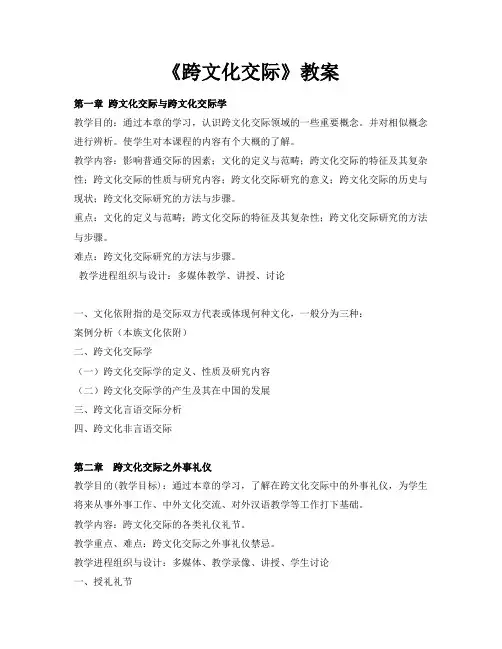
《跨文化交际》教案第一章跨文化交际与跨文化交际学教学目的:通过本章的学习,认识跨文化交际领域的一些重要概念。
并对相似概念进行辨析。
使学生对本课程的内容有个大概的了解。
教学内容:影响普通交际的因素;文化的定义与范畴;跨文化交际的特征及其复杂性;跨文化交际的性质与研究内容;跨文化交际研究的意义;跨文化交际的历史与现状;跨文化交际研究的方法与步骤。
重点:文化的定义与范畴;跨文化交际的特征及其复杂性;跨文化交际研究的方法与步骤。
难点:跨文化交际研究的方法与步骤。
教学进程组织与设计:多媒体教学、讲授、讨论一、文化依附指的是交际双方代表或体现何种文化,一般分为三种:案例分析(本族文化依附)二、跨文化交际学(一)跨文化交际学的定义、性质及研究内容(二)跨文化交际学的产生及其在中国的发展三、跨文化言语交际分析四、跨文化非言语交际第二章跨文化交际之外事礼仪教学目的(教学目标):通过本章的学习,了解在跨文化交际中的外事礼仪,为学生将来从事外事工作、中外文化交流、对外汉语教学等工作打下基础。
教学内容:跨文化交际的各类礼仪礼节。
教学重点、难点:跨文化交际之外事礼仪禁忌。
教学进程组织与设计:多媒体、教学录像、讲授、学生讨论一、授礼礼节1、何时送礼2、送什么礼物3、接受礼品二、演说三、告别礼节四、访问礼节四、馈赠礼品五、外事人员的个人礼仪第三章跨文化言语交际分析教学目的:通过本章的学习,了解言语交际的概念及重要性,并从微观处巡视中国文化与英美文化的不同。
教学内容:称呼、介绍、闲聊、问侯、致谢、道歉等。
重点与难点:中西跨文化言语交际中的不同。
教学进程组织与设计:多媒体教学、讲授、讨论一、“先生”的烦恼二、有序与无序——说介绍三、让“球”滚动的艺术——说闲聊四、“问我好,我受不了”——说问候五、千恩万谢为哪般——说致谢六、“对不起”不等于没道理——说道歉七、“每天至少称赞三个人”——说恭维八、私人领地不容侵犯——说禁忌九、不要拐弯抹角“打游击”——说请求十、“不要教训你老奶奶”——说关心十一、吃喝中的“卫生”习惯——说十二、“千里送鹅毛,不讲价多少”第四章非语言交际教学目的(教学目标):了解非语言交际在跨文化交际中的重要地位与作用。
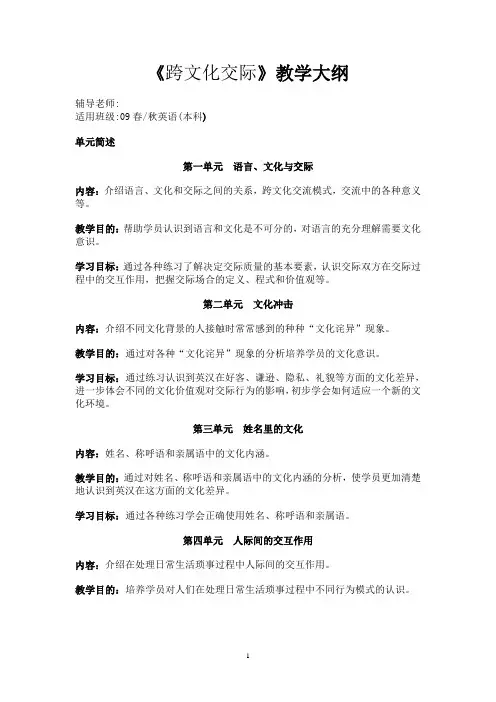
《跨文化交际》教学大纲辅导老师:适用班级:09春/秋英语(本科)单元简述第一单元语言、文化与交际内容:介绍语言、文化和交际之间的关系,跨文化交流模式,交流中的各种意义等。
教学目的:帮助学员认识到语言和文化是不可分的,对语言的充分理解需要文化意识。
学习目标:通过各种练习了解决定交际质量的基本要素,认识交际双方在交际过程中的交互作用,把握交际场合的定义、程式和价值观等。
第二单元文化冲击内容:介绍不同文化背景的人接触时常常感到的种种“文化诧异”现象。
教学目的:通过对各种“文化诧异”现象的分析培养学员的文化意识。
学习目标:通过练习认识到英汉在好客、谦逊、隐私、礼貌等方面的文化差异,进一步体会不同的文化价值观对交际行为的影响,初步学会如何适应一个新的文化环境。
第三单元姓名里的文化内容:姓名、称呼语和亲属语中的文化内涵。
教学目的:通过对姓名、称呼语和亲属语中的文化内涵的分析,使学员更加清楚地认识到英汉在这方面的文化差异。
学习目标:通过各种练习学会正确使用姓名、称呼语和亲属语。
第四单元人际间的交互作用内容:介绍在处理日常生活琐事过程中人际间的交互作用。
教学目的:培养学员对人们在处理日常生活琐事过程中不同行为模式的认识。
学习目标:通过练习学会处理邀请、约会、付帐、馈赠、请求、恭维、招待等行为中的文化差异,了解其中的一些不成文规则,更清楚地意识到自己的行为是如何受本族文化影响的。
第五单元角色和关系内容:介绍社会角色,如男和女、父母和孩子、朋友、社会身份等中的文化内涵。
教学目的:帮助学员分析社会角色和关系在不同文化中的期望值。
学习目标:意识到不同角色的不同期望值;意识到不同角色的不同责任;做到同其他文化背景的人交往时能够调整自己的期望值。
第六单元体态语交流内容:介绍体态语在跨文化交际中的重要作用。
教学目的:使学员熟悉不同种类的体态语以及不同文化对体态语的不同解释。
学习目标:通过练习能够描述体态语的不同意义;意识到成功的跨文化交际不仅需要知道如何用语言表达,而且要知道伴随恰当的体态语,在交流中有意识地注意脸部表情、目光接触、手势和身体位置、身体距离等。


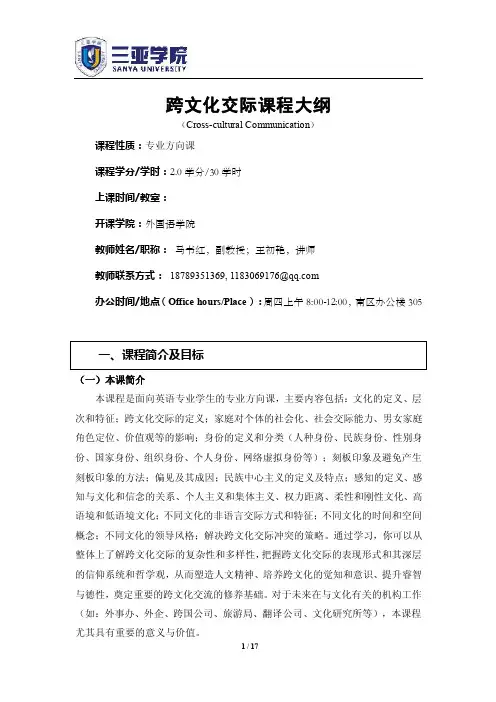
跨文化交际课程大纲(Cross-cultural Communication)课程性质:专业方向课课程学分/学时:2.0学分/30学时上课时间/教室:开课学院:外国语学院教师姓名/职称:马书红,副教授;王初艳,讲师教师联系方式:187****1369,*****************办公时间/地点(Office hours/Place):周四上午8:00-12:00,南区办公楼305一、课程简介及目标(一)本课简介本课程是面向英语专业学生的专业方向课,主要内容包括:文化的定义、层次和特征;跨文化交际的定义;家庭对个体的社会化、社会交际能力、男女家庭角色定位、价值观等的影响;身份的定义和分类(人种身份、民族身份、性别身份、国家身份、组织身份、个人身份、网络虚拟身份等);刻板印象及避免产生刻板印象的方法;偏见及其成因;民族中心主义的定义及特点;感知的定义、感知与文化和信念的关系、个人主义和集体主义、权力距离、柔性和刚性文化、高语境和低语境文化;不同文化的非语言交际方式和特征;不同文化的时间和空间概念;不同文化的领导风格;解决跨文化交际冲突的策略。
通过学习,你可以从整体上了解跨文化交际的复杂性和多样性,把握跨文化交际的表现形式和其深层的信仰系统和哲学观,从而塑造人文精神、培养跨文化的觉知和意识、提升睿智与德性,奠定重要的跨文化交流的修养基础。
对于未来在与文化有关的机构工作(如:外事办、外企、跨国公司、旅游局、翻译公司、文化研究所等),本课程尤其具有重要的意义与价值。
(二)课程目标本课程旨在实现下列5个教学目标:1、专业知识目标通过本课程的学习,你能够(1)了解不同文化的外在表现形式(如服饰、饮食、音乐、雕塑、庆典仪式、交往方式等)、特点和异同;(2)了解非语言交际的不同特征与要素;(3)了解跨文化交际能力的构成要素;(4)用目标语言来描述、对比和分析各种文化现象,将语言学习与文化学习相结合;2、思维方式目标在反思中国文化的天人合一、阴阳和合、大一统等整体性、模糊性、直觉性、意向性、崇拜权威的思考方式的基础上,了解与学习其他文化的思考方式、信念传统和价值观等,从而汲取不同文化的思维方式的优势,并学习在不同的情景下、不同的领域中采用适当的思维技术和方法来解决问题,避免非此即彼的对立、生硬的思考模式和处理问题的方法。
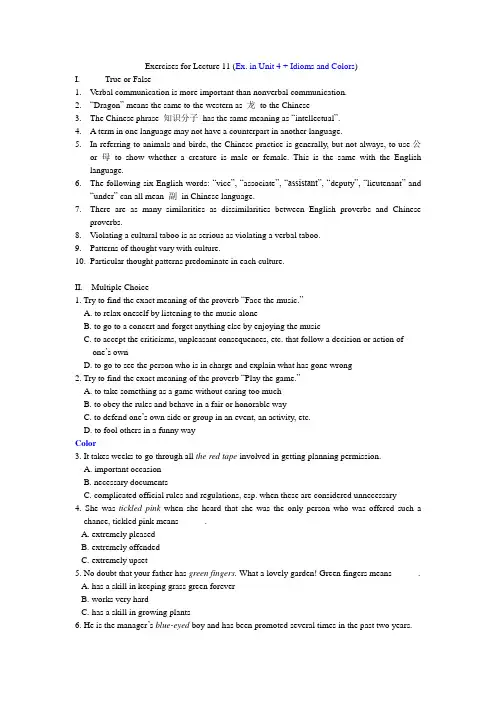
Exercises for Lecture 11 (Ex. in Unit 4 + Idioms and Colors)I.True or False1.Verbal communication is more important than nonverbal communication.2.“Dragon” means the same to the western as 龙to the Chinese3.The Chinese phrase 知识分子has the same meaning as “intellectual”.4. A term in one language may not have a counterpart in another language.5.In referring to animals and birds, the Chinese practice is generally, but not always, to use公or 母to show whether a creature is male or female. This is the same with the English language.6.The following six English words: “vice”, “associate”, “assistant”, “deputy”, “lieutenant” and“under” can all mean 副in Chinese language.7.There are as many similarities as dissimilarities between English proverbs and Chineseproverbs.8.Violating a cultural taboo is as serious as violating a verbal taboo.9.Patterns of thought vary with culture.10.Particular thought patterns predominate in each culture.II. Multiple Choice1. Try to find the exact meaning of the proverb “Face the music.”A. to relax oneself by listening to the music aloneB. to go to a concert and forget anything else by enjoying the musicC. to accept the criticisms, unpleasant consequences, etc. that follow a decision or action ofone’s ownD. to go to see the person who is in charge and explain what has gone wrong2. Try to find the exact meaning of the proverb “Play the game.”A. to take something as a game without caring too muchB. to obey the rules and behave in a fair or honorable wayC. to defend one’s own side or group in an event, an activity, etc.D. to fool others in a funny wayColor3. It takes weeks to go through all the red tape involved in getting planning permission.A. important occasionB. necessary documentsC. complicated official rules and regulations, esp. when these are considered unnecessary4. She was tickled pink when she heard that she was the only person who was offered such a chance, tickled pink means______.A.extremely pleasedB.extremely offendedC.extremely upset5. No doubt that your father has green fingers. What a lovely garden! Green fingers means______.A.has a skill in keeping grass green foreverB.works very hardC.has a skill in growing plants6. He is the manager’s blue-eyed boy and has been promoted several times in the past two years.A. a very handsome and capable personB. a person treated with special favor by somebodyC. a person who often irritates others7. He is still green and bound to make mistakes, but I think he will bear watching.A. childishB. too weak to depend on himselfC. lacking experience, not mature enough8. I called him several times but he was in a brown study and didn't hear me.A. indulging in his coffeeB. reading attentivelyC. thinking deeply9. I am afraid we should not go on chatting like this. The new manager could arrive out of blue.A. unexpectedly, without warningB. with an angry expressionC. to give somebody a lesson10. Our boss is rather stern and sometimes looks a bit haughty, but he isn’t really as black as he is painted.A. as dark-skinned as he is describedB. as dangerous as he is describedC. as bad as he is said to be11. The new office block has become an expensive white elephant.A. a thing that is rather large and eye-catchingB. a thing that is useless and often expensive to maintainC. a valued gift that shouldn’t be given away12. No doubt that your father has green fingers. What a lovely garden!A. Has a skill in keeping grass green foreverB. works very hardC. has a skill in growing plants.13. I know he has the gift of gab, but I am afraid he doesn’t have much grey matter.A. intelligenceB. moneyC. opportunity14. No matter how successful she has become, my sister is still regarded as the black sheep of the family.A. a person who is always quite and docileB. a person who will set the world on fire sooner or laterC. a person who is strongly disapproved of other members of his/ her family15. He has browned off with his job and decided to enter a university to study for his second degree.A. unequal toB. bore; fed upC. desperate for16. Proverbs are significant to the study of intercultural communication because_____.A. they provide a compact description of a culture’s valuesB. they tell a great deal about what a culture praises and what it rejectsC. Both A and B17. In English culture “white” connotes______.A. deathB. innocenceC. immaturity18. The English equivalent for “黄色书刊”is _______.A. filthy publicationsB. yellow publicationsC. vulgar publications19. The Chinese equivalent of “white house” is _______.A. 温室B.白房子C.绝尘室20. This is a rich district where many wealthy people live in their luxurious houses. Rich district means_____.A.a brown-stone districtB.a red-stone districtC.a white-stone district21. I am afraid something bad may happen. We need to prepare for the worst. The italicized part can be replaced by ________.A. I have seen the red lightB. I have seen the green light.C. I have seen the yellow light.22. The government has finally given permission to start the project that has been discussed for several years. The underlined part can be replaced by ________.A. given the red light toB. given the green light toC. given the yellow light to23. We seldom see you, but you are off the next minute. The italicized part can be replaced by ___.A. see you only in a blue moonB. see you only once in a silver moonC. see you only once in a grey moon.24. She has been in very good health after she made a habit of jogging every morning. The italicized part can be replaced by ________.A. in the brownB. in the redC. in the pink25. Mr. Johnson is the chief editor in this press who is responsible for crossing out or altering the offensive parts of a book before it is shown to the public. The italicized part can be replaced by __.A. holds the red pencilB. holds the blue pencilC. holds the black pencil26. What a relief when I found that I still have money in my bank account! But I can’t spend money like this any longer. The italicized part can be replaced by ________.A. I am in the redB. I am in the blackC. I am in the blue27. He was discovered in the act of cheating by looking up his textbooks in the examination. The italicized part can be replaced by ________.A. caught red-handedB. caught white-handedC. caught black-handed28. What a fabulous car----I am very jealous. The italicized part can be replaced by ________.A. red with envyB. blue with envyC. green with envy29. That’s only a harmless lie. I do n’t want to hurt her. The italicized part can be replaced by ___.A. a green lieB. a white lieC. a grey lie30. As a man with plenty of guts, he is the person who is expected to bring success to this company which is on the verge of bankruptcy. The italicized part can be replaced by ________.A. the white hopeB. the red hopeC. the green hope31. The new rules for police procedure cleared up a lot of ambiguous areas which had been difficult to deal with. The italicized part can be replaced by ________.A. black areasB. grey areasC. blue areasKEYSI. True or False1. F2. F3. F4. T5.F6.T7.F8.T9.T 10.TII. Multiple Choice1. C2.B3. C4. A5. C6. B7. C8. C9. A 10. C11. B 12. C 13.A 14. C 15. B 16.C 17. B 18. A 19. C 20.A21. A 22. B 23.A 24.C 25.B 26.B 27. A 28. C 29. B 30.A 31. B。
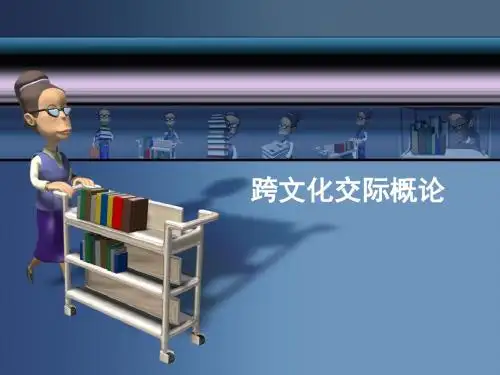
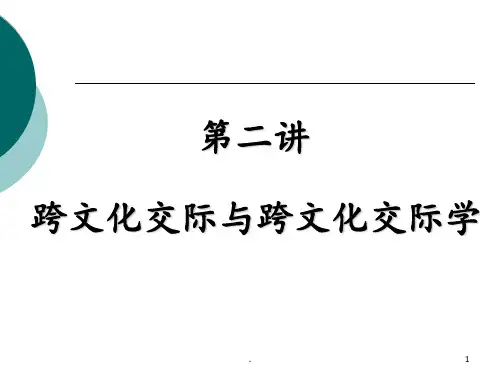
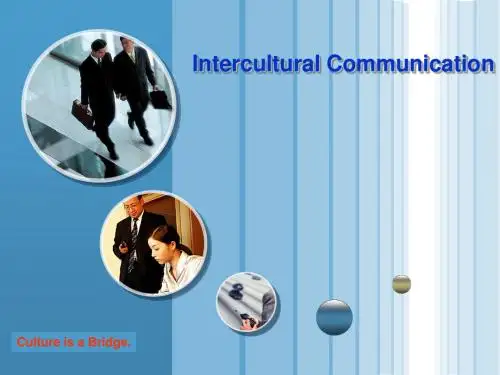
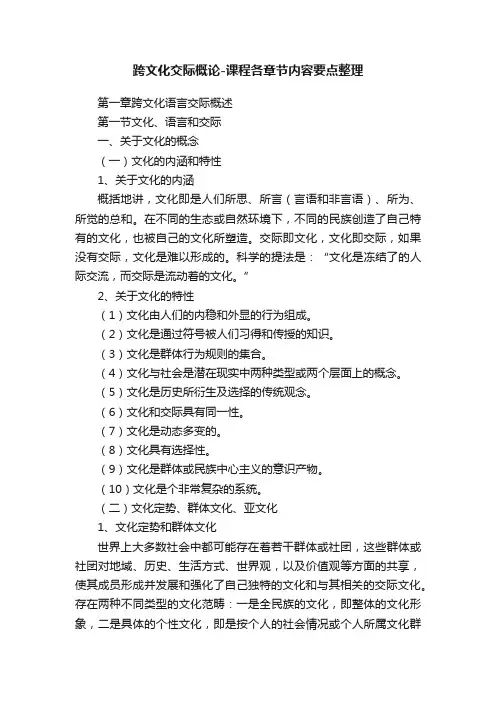
跨文化交际概论-课程各章节内容要点整理第一章跨文化语言交际概述第一节文化、语言和交际一、关于文化的概念(一)文化的内涵和特性1、关于文化的内涵概括地讲,文化即是人们所思、所言(言语和非言语)、所为、所觉的总和。
在不同的生态或自然环境下,不同的民族创造了自己特有的文化,也被自己的文化所塑造。
交际即文化,文化即交际,如果没有交际,文化是难以形成的。
科学的提法是:“文化是冻结了的人际交流,而交际是流动着的文化。
”2、关于文化的特性(1)文化由人们的内稳和外显的行为组成。
(2)文化是通过符号被人们习得和传授的知识。
(3)文化是群体行为规则的集合。
(4)文化与社会是潜在现实中两种类型或两个层面上的概念。
(5)文化是历史所衍生及选择的传统观念。
(6)文化和交际具有同一性。
(7)文化是动态多变的。
(8)文化具有选择性。
(9)文化是群体或民族中心主义的意识产物。
(10)文化是个非常复杂的系统。
(二)文化定势、群体文化、亚文化1、文化定势和群体文化世界上大多数社会中都可能存在着若干群体或社团,这些群体或社团对地域、历史、生活方式、世界观,以及价值观等方面的共享,使其成员形成并发展和强化了自己独特的文化和与其相关的交际文化。
存在两种不同类型的文化范畴:一是全民族的文化,即整体的文化形象,二是具体的个性文化,即是按个人的社会情况或个人所属文化群体为基础的文化,有的学者把这种文化称之为群体文化或副文化。
2、亚文化与亚群体在跨文化交际研究中,对文化分类的一种较为传统的做法是把文化分成主流文化和亚文化。
亚文化是指存在于某一主流文化之中的一种非主流文化,某一少数群体的文化,这一文化中的行为模式区别于主流文化的行为模式。
二、关于语言的概念(一)语言是交际工具1、交际媒介言语交际是人类社会中必需的另一种交换活动,交换的是信息、思想、情感。
语言就是一个符号系统,一个人脑子里贮存了符号和符号的组合规则,他就可以和别人交际,传情达意,沟通信息。
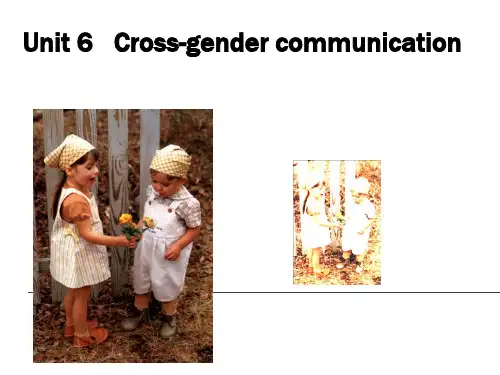
An Introduction to Intercultural CommunicationIn today’s class, you’ll learn…What is Intercultural Communication?Intercultural Communication (ICC) is communication between members of different cultures. ICCWhat are the categories of ICC?International Com.Interregional Com.Interracial Com.Interethnic Com.ICC as a Human ActivityEarly historySilk RoadMarco Polo’s stay in ChinaMonk Jian Zhen’s mission to JapanZheng He’s seven voyages to the Western SeaWhat makes ICC pervasive?Recent Development (four trends)Convenient transportation systemsInnovative communication systemsEconomic globalizationWidespread migrationsThe Importance of Raising ICC AwarenessCan you describe the phenomenon by one word?What competence is needed in successfully doing business internationally?Stumbling Blocks in ICCLanguage DifferencesAssumption of SimilaritiesNonverbal MisinterpretationsPreconceptions and StereotypesTendency to EvaluateSelf-check ListWhat is ICC?What are the categories of ICC?How important is raising ICC awareness?What are the stumbling blocks in ICC?Understanding CommunicationIn this class, you’ll be able toI. know different definitions of communicationII. identify various ingredients of communicationIII. analyze a communication process and recognize the components of communicationIV. identify the characteristics of communicationWhat is Communication?交际intercourse沟通link upTransmission of information (a message) between a source (sender) and a receiver, by using signaling system. (Oxford Dictionary)Communication is the process of exchanging information and meaning between or among individuals through a common system of symbols, signs, and behavior.Communication is a dynamic, systematic process in which meanings are created and reflected in human interaction with symbols.Features of CommunicationInteractive, systematic, symbolicII. Basic Ingredients of CommunicationSource (sender)EncodingMessageChannelReceiverDecodingSelf-check ListWhat is Communication?What are the features of Communication?What is the process of Communication?Verbal Communication—Lexical LevelIn today’s class, we will …understand the cultural influences on the meanings of wordsanalyze denotative and connotative differences between English and Chinese words I. Types of Lexical MeaningDenotation: primary, explicit, conceptualConnotation: supplementary, implicitCultural differences in denotative meaningA. Absence of equivalents in the speaker or listener's languageThe absence of the object “Kang”The absence of the word “Kang”The absence of objects, events, concepts, etc.The absence of the necessary vocabularyII. Cultural Differences in Denotative MeaningsB. The overlapping of denotative meaningKinship vocabularyuncle, aunt, grandpa, grandma, brother, sister, niece, nephew, cousinIII. Cultural differences in Connotative MeaningsFamilyKorean Top 3: mother father: children, brother, sister: relativeUSA Top 3: mother father: children, brother, love and friendshipMarriageUSA Top 3:Love; respect; responsibilitiesJapan Top 3:Trust; family; understandingFrance Top 3:Love; passion; sexColor WordsAnimal wordsChinese DragonWestern Dragon ImagePhonixDogOwlBatSelf-check ListThe cultural influences on the meanings of wordsDenotation and connotationThe connotations of some color words and animal wordsVerbal Communication—Pragmatic LevelIn today’s class, we will…look at cultural differences on pragmatic levelAddressingCompliments and Compliment ResponsesApologizingdiscuss on how these superficial behaviors are related to the cultural assumptions of the speakers I. AddressingA. Surnames and Given namesB. Addressing family members, relatives and neighborsC. The Use of TitlesIn Chinese : 宋局长,高经理,刘老师In English:Dr., Mrs., Miss, Ms, Mr. Judge, Governor, Mayor, PresidentD. The ways of getting the attention of a strangerIn Chinese: 同志,师傅,大哥,叔叔,……In English: Excuse me, Pardon meThe root of these differences lies in…Hierarchy & FormalityEqualityII. Compliments and Compliment ResponsesDifferences Between Chinese and English ComplimentsWho and what to complimentHow to complimentHow often to complimentHow to respond a complimentMembers of one’s familyA woman’s appearanceThe root of these differences lies in…MODESTYEqualityIII. ApologizingWhen to apologizeWho to apologizeHow to apologize and how to respondSelf-check ListCultural Differences on the Pragmatic LevelAddressing peopleCompliments and Compliment ResponsesApologizingNonverbal Communication (I)In today’s class, we will…understand what nonverbal communication is;know the function nonverbal communication serves;find out the elements of nonverbal communication;gain an awareness that successful ICC also depends on behaviors we displayI. Understanding Nonverbal CommunicationNVC involves all those nonverbal stimuli in a communication setting that are generated by both the source and his / her use of the environment and that have potential message value for the source or receiver. (Samovar, 2000: 149)Which carries more of the meaning, verbal or nonverbal communication?The importance of NVCII. The Functions of NVCWhen we say “The new library is south of that building”, we usually point in a certain direction. You tell someone that you are pleased with his/her performance, and at the same time you pat the person on the shoulder.If people in a group are boisterous, you might place your index finger to your lips as an alternative to saying, “Please calm down so that I can speak.”In a conversation we nod our head in agreement to indicate to our partners in communication that we agree and that they should continue talking.Just before the exam, you tell me you are relaxed and at ease, yet your voice quavers and your hands shake.III. Elements of Nonverbal Communication参见课本图例1. Making a GestureThe ring gestureBritain: _____France: _____Tunisia: ______U.S.: _____Latin America: _____Japan: _____The thumbs-upBritain: _____ & _____Sardinia: _____Greece: _____BeckoningAmerica: _____Malaysia: _____Yugoslavia: _____Indonesia: _____Australia: _____China: _____Pulling down the lower lid of the eye with one fingerFrance and Greece: _____England: _____Spain and Italy: _____South America: _____Ear-tugSpain: _____Greece: _____Malta: _____Italy: _____V-signBritain: _____Greece: _____2. PostureJapanese — bowing Status and rankAmericans — slouching Relaxed, informal attitude3. Facial ExpressionsMediterranean cultures: exaggerate signs of grief and sadness.U.S.: Men suppress the desire to show their emotions.China: Men never shed tears unless in extremely strongly-struck occasions.Japan: Men hide expressions by laughing or smiling.Smile = friendship?Far East: cover up embarrassment, dismay or furyJapan: mask an emotion; to avoid answering a question; to hide embarrassmentFrance: a person who grins too much =simpleGermany: smiles are reserved for family, friend and social situations, not in business settings.4. ParalanguageSelf-check ListThe definition of NVCThe functions of NVCThe elements of NVCGestures, postures, facial expressionsUnit 6Nonverbal Communication (II)— SPACE & TIMEElements of Nonverbal Communication参见书上图例In today’s class, we will…appreciate how attitude toward use of space and time convey nonverbal messages in ICC I. SpaceSpace speaks.When you invade my space, I will…feel troubledget defensivebecome aggressiveretaliateProxemicsthe study of personal space for the purpose of communication 近体学“Body Bubbles”American Interpersonal Distance (Hall, 1966)Intimate distancePersonal distanceSocial distancePublic distanceZones of SpaceIntimate distance0-45 centimetersPersonal distance45-80 centimetersSocial distance1.3-3 metersPublic distancefarther than 2 or 3 metersNorthern American Zones of SpaceCultural styles also determine the amount of personal space.Culture Variation of Body DistanceSmall space -----------------------------------------Large spaceJapaneseGermanAmericanFrenchArabLatin AmericanTouching times recorded in an hourTerritorialitythe pattern behavior associated with the defense of a territory 领地性The way people perceive territoriality is strongly influenced by culture.Cultural influence on territoriality can be best illustrated from the following two aspects: Attitudes towards crowdingPrivacyCrowding — how people feel when their personal space is limitedCausesPrivacyWesterners have a strong sense of privacy.Oriental culture does not emphasize privacy.Western View of Privacy“A man’s home is his castle.”Japanese View of PrivacyShoji Screen DoorsFusuma Sliding DoorsTatami FloorsII. TimeTime talksChronemicsThe study of the use and perception of timeTwo ways to study the concept of time(1) perceptions of past, present and future(2) monochronic vs. polychronicPast-oriented culturesemphasize tradition and historydiscourage change and innovationChina, Saudi ArabiaPresent-oriented culturesconsider the present as the only precious moment“Seize the day!”Mexico, the BahamasFuture-oriented culturesemphasize planning in order to achieve goalsencourage change and innovationU.S.Monochronic (一元时间) vs. polychronic(多元时间)M-time is noted for its emphasis on schedules, segmentation and promptness.P-time is less rigid and clock-bound.Self-check ListNVCspace Timeproxemics territoriality chronemicscrowding past monochronicprivacy present polychronicfutureUnit 7Cross-gender CommunicationIn today’s class, you will…understand the differences between male and female in communication learn effective cross-gender communication principlesThe Styles of CommunicationDebate vs. RelateReport vs. RapportCompetitive vs. CooperativeGender Differences in CommunicationBody languageFacial expressionSpeech patternsBehaviorPrinciples for Effective Cross-gender CommunicationB. Suspend JudgmentD. Recognize the Validity of Different Communication StylesA. Provide Translation CuesE. Seek Translation CuesC. Enlarge Your Own Communication StyleF. Suspend JudgmentSelf-check ListGender differences in communicationBody languageFacial expressionSpeech patternbehaviorSix principles for effective cross-gender communicationUnit 8Understanding CultureIn today’s class, we’ll…⏹understand the definitions of culture;⏹identify the ingredients of culture;⏹describe the features of culture.I.What is Culture?⏹Culture is everything.⏹Culture is opera, art, and ballet.⏹Culture may be defined as what a society does and thinks.⏹What really binds men together is their culture.⏹ A culture is a collections of beliefs, habits, living patterns and behaviors which areheld more or less in common by people who occupy particular geographic areas.Define culture from different perspectivesFrom Intellectual PerspectiveFrom Anthropological PerspectiveFrom Social PerspectiveFrom Intercultural Communication PerspectiveFrom Intellectual Perspective⏹According to the Concise Oxford Dictionary, culture is “the arts and othermanifestations of human intellectual achievement regarded collectively”.From Anthropological Perspective⏹Culture is “the customs, civilizations, and achievements of a particular time orpeople”.⏹This is an anthropologist’s definition.From Social Perspective⏹Culture is what a society does and thinks.⏹Culture covers everything of a society.From Intercultural Communication PerspectiveCulture is a learned set of shared interpretations about beliefs, values, and norms, which affect the behavior of a relatively large group of people.What is Culture⏹That complex whole which includes knowledge, belief, art, law, morals, custom and anyother capabilities and habits acquired by man as a member of society.⏹---Edward B. TylorII. Three Ingredients of CultureMaterial objectsBeliefs & value systemsBehavior patternsThree Layers of CultureSubcultureBody of Cultural TraditionsCultural UniversalsIII. Features of CultureA. Culture is learnedB. Culture is usually acquired unconsciouslyC. Culture is shared among its membersD. Culture is persistent and enduringE. Culture manifests itself both implicitly and explicitly — Iceberg TheoryF. Culture is adaptive and changeableG. Culture is relationalIceberg TheoryMaterial culture (small iceberg tip)Cultural values (huge iceberg body)Culture is like an onion核心是values, 有里向外依次为:rituals, heroes, symbolsSelf-check List⏹What is Culture?⏹What are the components of culture?⏹What are the layers of culture?⏹What are the features of culture?Unit 9Cultural DiversityIn today’s class, we’ll…⏹understand the difference between different cultures;⏹distinguish individualism from collectivism;⏹summarize dominant American cultural patterns.A. What is Cultural Diversity?Cultural diversity is the variety of human societies or cultures in a specific region, or in the world as a whole. independenceSelf-relianceSelf-esteemIndividualism egalitarianismB. Individualism vs. CollectivismJapan :The nail that sticks up will be pounded down.China: 枪打出头鸟。
Week 1 & 2A Brief Introduction to Intercultural CommunicationCourse: Intercultural CommunicationTeaching aim of this term:To make students understand the relationship between language and culture to foster intercultural communication awareness and develop intercultural communicative competence and to comprehensively improve the overall quality.Requirements for the course:before class, prepare the lesson;during the class, take notes very carefully;after class, finish the exercises.Your final score:homework + class performance + midterm exam = 40%term exam = 60%Introduction:Intercultural Communication & Cross-culturalUnit One & Two Communication, Culture and Intercultural CommunicationI. What Is Communication?Decide whether the following are examples of communications or not? Why?1.You complain to your instructor about your course credits through telephone.2. Two blind people exchange ideas in Braille.3. A German businessman negotiates, through an interpreter, with his Chinese counterpart.4. A farmer gives instructions to his ploughing cow.5. A programmer issues commands to a computer.6. Tom talks to himself while flourishing his toy gun.7. You send an e-mail message to an American friend.8. Jane lies in bed reading a novel.The Basics of Communication:Communication occurs if: 1. two or more people; 2. contact; 3. a shared language; 4.an exchange of information.Please read over the article on pages 50-59. What are the elements of communication?Context: four aspects (the physical setting, historical aspect, psychological aspect, culture aspect)Participants: three variables (relationship, gender, culture)Messages: meanings, symbols, encoding and decoding.Channels: the method used to deliver a message (sound, sight, smell, taste, touch, or any combination of these)Noise (干扰): a term used for factors that interfere with the exchange of messages, including external noise, internal noise and semantic noise. Noise is inevitable.Feedback: the response of a receiver to a sender‟s messageDefinition:“Communication may be defined as that which happens whenever someone responds to the behavior or the residue of the behavior of another person.”---- L. A. Samovar, et al Key points:①The behavior includes verbal behavior and non-verbal behavior.②the meaning of “behavior residue": simultaneous communication and non-simultaneous communication.③ A behavior, whether intentional or unintentional, conscious or unconscious, once is received, communication occurs.④Feedback is not a prerequisite of communication. So there may be one-way communication.2. Factors Affecting CommunicationEight specific ingredients of communication:①the source (行为源): a person who has a need to communicate②encoding (编码): an internal activity in which a source creates a message through the selection of verbal and non-verbal symbols (行为源组织信息的内心活动).③message (信息): the result of encoding, once spoken out and received, becomes a message.④channel (渠道): the physical means by which the message is transmitted.⑤the responder (反应者): the person who intercepts the message and as a consequence becomes linked to the source.⑥decoding (译码): the internal activity of the receiver‟s information processing.⑦response (反应): what a receiver decides to do about the message.⑧feedback (反馈): feedback and response are clearly related. Response becomes feedback when received by the source.Of the eight ingredients, the source and the responder, encoding and decoding, are themost important because they are related to persons.Some personal factors: sex, age, temperament, occupation, social status,knowledgestructure,life experience, etc.Uncertain factors, varying at different time: intention, mood, status at that time, etc. Objective factors: time, place,occasion.3. Communication Types①based on symbols used: verbal and non-verbal②based on media: direct and indirect③based on feedback: two-way and one-way④based on numbers of the sources and responders: one/group-to-one and one/group-to-group⑤based on set responder: directed and non-directed⑥based on the source‟s intention: intentional and unintentional⑦based on the responder‟s activeness: active and passive⑧based on time: simultaneous and non-simultaneous*Further Explanations:Two-way communication: Communicators can see each other and monitor each other’s behaviour-- direct communication.One-way communication: communicators cannot see each other, and hence cannot monitor each other’s behaviour -- indirect communication.4. Characteristics of Communication (P68-72)①Communication is dynamic. It is an on-going, ever-changing activity. We are sure to be influenced by other‟s message, whether gradually or radically.②It is interactive (interpersonal communication).③It is irreversible.④It is contextual.More:Communication is systematic:Communication does not occur inisolation or in a vacuum, but rather ispart of a larger system. We send andreceive messages not in isolation, but ina specific setting. Setting andenvironment help determine the wordsand actions we generate. Dress,language, topic selection, and the likeare all adapted to context.Communication is symbolic: Symbols are central to the communication processbecause they represent the shared meaningsthat are communicated. A symbol is a word,action, or object that stands for orrepresents a unit of meaning. People'sbehaviors are frequently interpretedsymbolically, as an external representationof feelings, emotions, and internal states.Communication is self-reflective: Human beings have a unique ability to think aboutthemselves, to watch how they define theworld, and to reflect on their past, present,and future.II. What Is Culture?Please read over the article on pages 40-44. What can you learn about culture from it?1.People who know about art, musicand literature are cultured….2. People have to learn the cultural ways of their community; they are not something that the people in the group are born with.1.O rigins of culture in English and Chinese (1)“Culture” is a loan word from Latin meaning “cultivating or tilling the land”. It was originally associated with physical activities and production of food. Later, its meaning was extended to include mental, moral, aesthetic, educational and intellectual activities. In contemporary English its original meaning is still retained.(2)“文化” is a native word in Chinese. “文” and “化”were used together in the Warring States. “人文” in “观乎人文,以化成天下” refers to the interwoven relationships between the monarch and his subjects, fathers and sons, husbands and wives, brothers and friends, and “化”means “changing and/or cultivating”. When used together, “文” and “化” mean “以文教化”. They were combined into one word in Han Dynasty, with its meaning contrasted with “nature” on one hand and “primitiveness”and “savage”on the other hand. So “文化” was originally associated with mental activities.2.D efinitionWhat really binds men together is their culture--- the ideas and the standards they have in common.— R. BenedictAccording to The Concise Oxford Dictionary, culture is “the arts and other manifestations of human intellectual achievement regarded collectively”.Defining Culture from the Anthropological Perspective:♦“Culture consists of patterns, explicit and implicit, of and for behavior acquired and transmitted by symbols, constituting the distinctive achievement of human groups, including their embodiments in artifacts; the essential core of culture consists of traditional ideas and especially their attached values”.-----Kroeber and KluckhohnDefining Culture from the Psychological Perspective♦culture is "the collective programming of the mind which distinguishes the members of one category of people from another".----Geert HofstedeDefining Culture from the SociologicalPerspective♦“Culture is defined as a pattern of learned, group-related perception —including both verbal and nonverbal language attitudes, values, belief system, disbelief systems, and behavior”.Defining Culture from the Intercultural Perspective♦“Culture is a system of shared beliefs, values, customs, behaviours and artifacts that are transmitted from generation to generation through learning.”[Bates and Plog]A. Culture in its broad senseCulture is the attribute of man, or, whatever distinguishes man from the rest part of the world is culture. Based on this, Prof. Lin Dajin provides a Chinese counterpart definition: 文化是人类区别于动物的综合特征. It may include the following components:①Materials man has got to satisfy his needs, including science and technology, such as space shuttles, airplanes, and cars;②Social institutions and organizations man has established, including socioeconomic institutions, politico-legal institutions, and religious organizations;③Knowledge about nature and man himself and artistic development, including various subjects such as mathematics and education, and artistic forms such as literature, painting, music and dance;④Language and other communication systems such as gestures and facial expressions;⑤Customs, habits and behavioral patterns;⑥Value systems, world views, national traits, aesthetic standards and thinking patterns.Culture in this sense is also called “large C culture” or academic culture or culture with a big C(大写字母的文化). It‟s culture in general, culture of all nationalities and ethnic groups. Butwe know there are specific cultures such as Chinese, American and British. According to this sense, specific culture can be defined (by Prof. Lin Dajin) as the comprehensive features that distinguish one group (be it a nation, a race or any section of people) of people from another (一个民族区别于另一个民族的综合特征).﹡Dominant culture and subculture/co-culture ♦Culture is subdivided into dominant culture, mainstream culture, and subculture(s), which coexist within each culture.♦A subculture resembles a culture in that it usually encompasses a relatively large number of people and represents the accumulation of generations of human striving. However, subcultures have some important differences: they exist within dominant cultures and are often based on economic or social class, ethnicity, race, or geographic region.Today the tendency is to say …co-culture‟ and sub-groups to avoid prejudice.B. Culture in its narrow senseIt's called “small c culture” or anthropological culture or culture with a small c (小写字母的文化). It can be defined as life way of a population, Culture in this sense emphasizes what characterizes the way of life of a people, including components ②, ③, ④, ⑤and ⑥, with components ②, ④, ⑤and ⑥as the central part.Some scholars are interested in “large C culture”while others in “small c culture”, depending on the purpose of investigation. We shall focus on culture in its narrow sense.﹡Cultural Identity♦Cultural identity refers to one‟s sense of belonging to a particular culture or ethnic group. People consciously identify themselves with a group that has a shared system of symbols and meanings as well as norms for conduct.3.P roperties of culture(1)It is human specific.(2)It is a social phenomenon (contrast between society and nature). It is the embodiment of human knowledge, skill and cooperative labor. (3)It is a national phenomenon for each nation has its own culture.(4)It is a historical phenomenon. Each culture has some history and each generation contributes to it. But culture won‟t necessarily remain the same.(5)It is general and abstract.III. Intercultural CommunicationPlease read over the article on pages 4-7. What can you learn about intercultural communication from this article?Please read over the article on pages 12-15. How is IC different from communication within the same culture?1.D efinitionIC is concerned with communication among people from different cultural backgrounds. Intercultural communication refers to communication between people whose cultural perception and symbol system are distinct enough to alter the communication event.2.F orms of IC(1) International Communication: International communication takes place between nations and governments rather than individuals; it is quite formal and ritualized(仪式化) .(2) Interethnic Communication: Ethnic groups usually form their own communities in a country or culture. These groups share a common origin or heritage that is apt to influence family names, language, religion, values, and the like.(3) Interracial Communication: Interracial communication occurs when the sender and the receiver exchanging messages are from different races.(4) Intracultural Communication: It is defined ascommunication between or among members of the same culture.3.F eatures(1)It is a branch of communication.(2)It mainly deals with verbal and nonverbal interaction and related factors in intercultural communication.(3)Its verbal medium is language while its nonverbal communication systems include body language, facial expressions, etc.IV. History and Present State of IC Studies1.I C and IC studiesIC studies are rather new while IC (activities) is almost as long as our human history:2.I C Studies in USA and ChinaAlthough the beginnings of the field of intercultural communication as a field can be traced back to the 1920s in the teaching of linguistics and in various academic and youth-oriented programs, communication scholars commonly recognize E. T. Hall as the father of the field of intercultural communication study (Condon, 1981; Dodd, 1982; Gudykunst, 1985; Singer, 1987). Hall introduced terms such as "intercultural tensions" and "intercultural problems" in 1950.①The Burgeoning PeriodIn 1958, Lederer and Burdick's The Ugly American first raised mass awareness of intercultural issues, but the term "intercultural communication" itself did not appear until Hall's The Silent Language was published in 1959. The same book paved the way for the study of intercultural communication. Hall continued his theorizing about intercultural communication in other books, including The Hidden Dimension (1966), Beyond Culture (1976), The Dance of Life (1984), and Understanding Cultural Differences (Hall & Hall, 1989). His works continue to influence the development of the field of inter-cultural communication.②From 1960 to 1970Hall's influence on the study of intercultural communication is far-reaching. His writings have attracted numerous scholars to the study of intercultural communication. In addition to Kluckhohn and Strodtbeck's (1961) discourse on cultural value orientations, which provides an important conceptual contribution to the field, two representative books reflect the continuous efforts made by scholars in the field in the 1960s: Oliver's Culture and Communication (1962) and Smith's Communication and Culture (1966). Oliver's study focuses on Asian philosophy and communication behaviors, especially from a rhetorical perspective. His book establishes a model for the comparative study of communication behaviors between cultures. Smith's book is a collection of essays on human communication covering thirteen types of communication studies. Although only four articles on intercultural communication are included in the book, their presence confirms the status of intercultural communication as a field of study. The first college class in this field taught in 1966 at the University of Pittsburgh.③From 1971 to 1980The 1970s witnessed rapid development in the field of intercultural communication. In 1972, after three years of refining his model of intercultural communication, Stewart published his American Cultural Patterns. In 1973, Samovar and Porter published Intercultural Communication: A Reader, and Indiana University awarded the first doctoral degree in intercultural communication. Many books on intercultural communication became available in the years that followed.The publication of Asante, Blake, and Newmark's The Handbook of Intercultural Communication in 1979 highlighted the achieve-ments of intercultural communication scholars in the 1970s. In addition, The International Journal of Intercultural Relations began publication in1977. The journal influenced research in the field of intercultural communication in the years that followed. Disorder characterizes the initial development of the field. Intercultural communication scholars pursued their own directions and definitions, with few attempts at integration. It was not until the 1980s that the field began to move from disarray to a more coherent focus.④From 1981 to the Present TimeTheory building and methodological refinement characterize intercultural communication study during this decade. The book Theories in Intercultural Communication by Kim and Gudykunst (1988) features two approaches to theory building. First, the study of intercultural communication draws from existing communication theories in constructivism, coordinated management of meaning, uncertainty reduction theory, communication accommodation theory, network theory, and convergence theory. Second, most intercultural communication theories focus on the interpersonal communication level with a brief mention of rhetoric. These two characteristics served to define the mainstream study of intercultural communication in the 1980s. Methodologically, the traditional quantitative and rhetorical-interpretive research methods used in the communication discipline were also applied to the study of intercultural communication.This course was introduced to the Chinese scholars in 1980s. According to Hu Wenzhong in 1995 there were only Beijing Foreign Studies University, Heilongjiang University, Harbin Industrial University, Shanghai Foreign Studies University and Fujian Teachers University. It is rather new in China.。
《跨文化交际》课程标准2023年10月目录一、课程信息 (1)二、课程性质与任务 (1)(一)课程性质 (1)(二)课程任务 (2)三、课程目标与要求 (2)(一)课程目标 (3)(二)课程要求 (4)四、课程结构与内容 (5)(一)教学内容选择与组织原则 (5)(二)教学内容组织构架 (6)五、学生考核与评价 (8)六、教学实施与保障 (9)(一)教学实施 (9)1.教学理念 (9)2.教学模式 (9)3.教学方法与手段 (10)4.学法 (11)5.教学实施过程 (12)(二)教学实施保障 (14)1.师资保障 (14)2.教学资源保障 (14)一、课程信息课程名称:跨文化交际学时:64学分:4适用专业:旅游英语、商务英语、旅游管理、导游二、课程性质与任务(一)课程性质《跨文化交际》课程是旅游英语专业和商务英语专业的专业核心课程,同时也是旅游管理、导游等专业方向的专业基础课程,是一门理论知识和实践技能并重的理实一体化课程。
课程定位于培养学生利用现有教育资源,让学生掌握跨文化交际理论的基本知识,增强学生对跨文化交际中文化差异的敏感性,培养学生的跨文化交际能力,具备在多元文化背景中开展跨文化旅游交际活动的基本素质,达到有效解决各类因文化差异而产生的问题的职业要求。
课程安排在第三学期,后续课程有:旅游英语、英语口笔译实务、目的地和客源国概况等。
通过本课程学习,学生了解了对跨文化交际的基本理论,掌握了一定的跨文化服务能力。
本课程的学习对旅游英语专业人才职业能力培养和职业素养养成起着重要的支撑作用。
(二)课程任务课程主要帮助学生掌握跨文化交际的基本理论、基本技能以及相关的礼仪,经由跨文化交际基本理论指导下主要国家交际的介绍、理解和必要的运用,以培养学习者开展日常交往、接待、策划、谈判等必要的跨文化交际能力。
课程教学坚持以学生为主体,结合十二个模块的内容,突出对学生跨文化交际能力的训练,国际化视野和多元文化视野的培养。
Week 9&10Unit 6 Nonverbal Communication Questions for discussion:1.What is nonverbal communication?2.Is it possible to communicate without nonverbal means? Why or why not?3.What functions does our nonverbal behavior serve in communication?I.What is Nonverbal Communication?Nonverbal communication is the process by which nonverbal behaviors are used, either singly or in combination with verbal behaviors, in the exchange and interpretation of messages within a given situation or context. (L. A. Malandro, 1983)The messages sent without using words are called nonverbal communication.(i) Its features:1.It’s communication in which words orspeech sounds are not used.2.It conveys meaning.3.It involves such non-verbal dimensionsas facial expressions, touch, time, gestures, smile, eye behaviors, smell, intonation, etc.4.It’s a discipline studying non-verbalbehavior in communication.5.It’s first of all used to convey messagesto and receive messages from others.6.It’s a process of communication bymeans of non-verbal behaviors.7.It may convey messages alone or incombination with verbal behaviors.8.It occurs in a given context or situationand is interpreted in relation to that situation or context.(ii) Its significanceNonverbal behavior is a significant area of communication study for at least three reasons. ♦Nonverbal behavior accounts for much of the meaning we get from conversations.♦Nonverbal behavior spontaneously reflects the subconsciousness. They are relatively free of distortions and deception.♦We cannot avoid communicating throughnonverbal signals.Besides, nonverbal behavior is significant because nonverbal communication can be open to many interpretations.(iii) Its functions (p 227-231):1.Repeating: People use nonverbalcommunication to repeat, clarify, and emphasize their point of view.plementing: Nonverbalcommunication cues can add to or complement a verbal message.3.Substituting: Nonverbal messages maysubstitute verbal ones in certain settings.4.Regulating: Nonverbal behaviors canhelp control verbal interactions by regulating them, such as turn-taking signals (hand raised) in conversations.5.Contradicting: Certain nonverbalbehaviors can contradict spoken words.E.g. Saying you are relaxed and at easewith quavering voices or shaking hands.(iv)❊Non-verbal communicationincludes: (Knapp, 1972)kinesics or body language, eye movement, facial expressions, proxemics and paralanguage.II.KinesicsKinesics, that is commonly called as body language, is the term used for communicating through various types of body movements including gestures, posture, touching, and other mannerisms that may accompany or replace oral messages.(i) Gestures: (p203-205)Gestures are an important component of non-verbal communication. This is mainly a matter of how we use our hands to convey a message. The language of the hands differs from country to country and a gesture which means one thing in one country may well mean something quite different to those living in another.1.Similarities:①Rubbing one’s thumb against one’sforefinger and middle finger—money inChinese and English.②Shaking one’s head—disagreement or disappointment.③Shaking hands when introduced or meeting together after a long time.2.Differences:①It’s me or I’m the one—touch or point toone’s nose by raised thumb.②Come here—extending a closed hand,palm up, with only the forefinger movingback and forth.③Shame on you—extending both hands,palms down, with forefingers stretchingout and one forefinger makes severalbrushing movements over the back of theother forefinger.④Hitchhiking—moving several time aclosed hand with an outstretched thumbopinion to the intended direction.(American method)—walking on the same side of theroad and in the same direction as thecar traffic, and extend the thumb ofyour roadside arm toward the front.(European method)⑤Kill oneself—raising one’s closed handto one’s head with the forefinger and the thumb stretching out and the forefinger pointing to the temple.⑥I’m full—an open hand, palm down,raised to ones throat⑦Good luck—crossing one’s forefingerand middle finger.⑧Stamping one’s foot—impatience.⑨Thumbing one’s nose (one thumb on thetip of one’s own nose with other finger s curled and moving together)—defiance and contempt.⑩W agging one’s forefinger (the forefinger of one hand is raised and wagged from side to side while other fingers are lasped)—warning.※more materials will be shown on PPT“Gesture”.Exercise p214(ii) Posture身势语:Posture, the way someone stands, sits, or walks, can send positive or negative nonverbal messages. Posture can signal agreement or disagreement. Appropriate posture is related to a person’s status in society. For example, the manager may stand erect when talking to subordinates, but the subordinates may drop their shoulders when talking to the manager.English speakers’, especially Americans’ postures are more casual than Chinese speakers’: ①sitting on a desk with both feet on another desk. ②Putting one’s feet on the writing table in a crowded office while sitting in an armchair. ③Making big strides while walking. ④Sitting on the grass or on the carpet (but never squatting in public).※In western conversation, the speaker who is standing is superior to the other who is sitting in ranks or status or ages. It is the opposite inChinese conversation. The junior or inferior one should stand and show his/her respect and subordinate to the senior or superior.(iii) Touching behavior: (p 210-212) Differences in touching behavior are highly correlated with culture. People in high contact cultures evaluate “close ”as positive and good, and evaluate “far” as negative and bad. People in low contact cultures evaluate “close ”as negative and bad, and evaluate “far” as positive and good1. handshaking2. embrace3. kiss(iv) artifacts or attireIII.E ye movement (p205-208)Eye contact is an important aspect of body language. One could draw up quite rules about eye contact: to look or not to look, when to look and how long to look, and who not to look at, etc. And these rules vary from culture to culture.When conversing with English speakers, we had better prolong eye contact with them. Look at the speaker directly in the eye while listening, and look away intermittently while speaking.Staring or gaping shows one’s curiosity or surprise in Chinese but impoliteness or embarrassment in English. A prolonged gaze or stare in the United States is considered rude. In other cultures such as Japan, Korea, and Thailand, staring is also considered rude. Inmost cultures, men do not stare at women. In France and Italy, however, men can stare at women in public. In the United States, staring at a person is considered a sign of interest and may even be interpreted as sexually suggestive.IV.Facial expressions:1. Read over the article (p208-210) and explain the different understanding of smiles at a stranger in these countries.Japan: either a sexual maniac or an impolite person.Korea: never talk or smile at strangers. Arab: something wrong with the stranger’s clothes or others.Vietnam: Americans are superficial for they smile too much. Nonverbal language, like a silence, a smile, a glance, has its own meaning.※Laughing: A native English speaker walking along the street suddenly stumble and fell. The Chinese persons who saw this laughed.※Smiling: Both Chinese and English speakers would smile when they meet friends, colleagues, classmates or acquaintances. But Americans tend to smile even to strangers to show friendliness. Even a girl may smile to a male stranger for no reason other than showing friendliness.2. Read case 22 on p216-217. What does laughing serve in the mentioned situation?V.Paralanguage (p201-203)We communicate with more than the words we speak. Effective speakers use vocal qualities to suggest different meanings from exactly the same words, like the manner of speech, intonation.VI.Some Nonverbal Patterns in the Black Culture (p218-221)1.rolling the eyes2.the reluctance to look another persondirectly in the eye3.limp stance4.Black walkVII.Silence in Western Apache Culture1.meeting strangers:2.courting3.children, coming home VIII.Case Analysis Case 20 (p214-215) Case 21 (p215-216) Case 22 (p216-217)。
Week 11Unit 7 Time and SpaceQuestions for discussion:1.I f you were invited to another family’s house for dinner when would you arrive?2.H ow long would you have to wait in a line in the post office before you became upset?3.H ow long do you think a party at which dinner is served should last?4.I f you were having a party in your class, how many days in advance would you invite your teachers or students from another college?5.W hen first meeting a newcomer to your class or a friend’s parents, an appropriate amount of time to talk with them would be minutes.6.I f you had an appointment with a professor at 8:00 and arrived at 8:45, how would the professor react?I.ChronemicsChronemics is the study of how peopleperceive and use time.(i) The Silent Language (p239-241)1. Traditions and conventions are silent inthe sense that they are often unconscious.2. What would an American businessmando if he is 3 minutes late for an appointment? What if 4 minutes late? 5 minutes late?3. What would you do in theabout-mentioned situation?4. The Western tradition of envisioningtime as a line:※The sense of time:1) Time is linear. Western cultures thinktime is linear — a flow from the pastto the present to the future.2) Time is cyclical. Life on earth evolvedin response to the cycles of day andnight and the ebb and flow of thetides.(ii) Monochronic and Polychronic Time (p271-275)1. What is M-Time and P-Time? Which do you think is the dominating time system in our culture?1) Monochronic time means paying attention to and doing only one thing at a time – events scheduled as separate items.2) Polychronic time means being involved with many things at once.2. What is the philosophy underlying each of the time system?1) P-time stresses involvement of people and completion of transactions rather than adherence to present schedules. Appointments are not taken as seriously and, as a consequence, are frequently broken. P-time is treated as less tangible than M-time.Weakness: Matters in a polychromic culture seem in a constant state of flux. Appointments are frequently broken.2) In M-time system, social and business life is commonly schedule-dominated. Byscheduling, we compartmentalize; this makes it possible to concentrate on one thing at a time, but it also reduces the context. M-time is also tangible. M-time scheduling is used as a classification system that orders life.Weakness: Life in general is at times unpredictable. M-time reduces the context and alienate people from themselves and from others.(iii) Social Time: The Heartbeat of Culture (p244-247)1.W hat does the author want to tell us fromhis experience in Brazil and the questionnaire between students in Niteroi and those in Fresno?2.T here aren’t unanimous perceptions oftime among culturally different people.Even within one country, ideas of time and punctuality vary considerably from place to place. Different regions and even cities have their own distinct rhythms andrules.3.W hat do you think of being punctual?How do the Westerners define punctuality with measures of time?4.Appreciating cultural differences intime sense becomes increasingly important as modern communications put more and more people in daily contact. If we are to avoid misreading issues that involve time perceptions, we need to understand better our own cultural biases and those of others.※American Concept of Time: (See Case 23 & 24)II.ProxemicsA fascinating area in the nonverbal world of body language is that of spatial relationships, or proxemics, the study of man's appreciation and use of space. As a species, man is highly territorial but we are rarely aware of it unless our space is somehow violated. Spatial relationships and territorial boundaries directlyinfluence our daily encounters. Maintaining control over such space is a key factor in personal satisfaction; observing spatial interactions in everyday life is a key to personal awareness.(i)The study of proxemics includes three aspects of space: (a) fixed features of space.(b) semifixed features of space, and (c) personal space(a) fixed features of spaceFixed feature space is characterized by unmovable boundaries, like divisions within an office building. Architecture and spacing of buildings also belong to this aspect of space.(b) semifixed features of spaceSemifixed features of space refer to spatial arrangements of movable objects within a room, such as furniture arrangement and seating.1. furniture arrangement :French space is a reflection of Frenchculture. Everything is centralized, and spatially the entire country is laid out around centers.In Germany, where privacy is stressed, office furniture is spread throughout the office.In Japan, where group participation is encouraged, many desks are arranged hierarchically in the center of a large, common room absent of walls.Chinese geomancy, feng shui, is the art of arranging the physical environment to establish harmony with the natural environment to achieve happiness, prosperity, and health.2. seatingIn the United States, they tend to talk with those opposite them rather than those seated or stand beside them.The Chinese often experience uneasiness when they face someone directly or sit on opposite side of a desk or table fromsomeone.(c) personal space (p254-256)Behavioral study indicates that individuals perceive a distance that is appropriate for different types of messages; they also establish a comfortable distance for personal interaction and nonverbally define this as their personal space.Research supports the hypothesis that the violation of this personal space can have serious adverse effects on communication.Thus, if an individual is to be mutually satisfied in a communication encounter his/her personal space must be respected.Should an intruder invade this personal space while also trespassing within territorial boundaries he placed himself in double jeopardy and must compensate for the other's increased anxiety.The differences among Americans, the Japanese and the Arab (p255)In the United States,Hall reports thatpsychologists have identified four zones from which U.S. people interact: the intimate zone, the personal zone, the social zone, and the public zone.In India, there are elaborate rules about how closely members of each caste may approach other castes.In Arab, Arabs of the same sex do stand much closer than North Americans. An Arab entering an elevator may stand right next to another person and be touching even though no one else is in the elevator. (ii) TerritorialityTerritoriality refers to how space can be used to communicate messages.Territorial claims differ from personal space in that the personal zone accompanies the individual while territoriality is relatively stationary. Semi-fixed feature space is often the criteria used to establish a territory within any environment; it becomes a man's safety zone where he rests from the rigors ofdefending personal space from invasion, the dramatic or sudden entry into another's personal zone. Humans, like animals, indicate their ownership of this established territory and will consequently defend it against all invasions. Territoriality is established so rapidly that even the second session in a series of lectures is sufficient to find most of the audience returning to their same seats. And if one has been sitting in a particular seat and someone else occupies it, one can notice a fleeting irritation.Compare the differences among the cultures of the countries mentioned in ―Home and Culture‖ (p258-262).America: showing visitors around home;people are not allowed to lock doors except the bathroom door; kitchen is the place for negotiation between the mother and the children; the parents’bedroom is mostly off-limits.Germany: requires a wide area of privacy,formal and regimented; doors are firmly shut between rooms; an entrance hall to lead visitors into the house without showing specific rooms and spoiling the family’s privacy.Northern European countries: rude if not call in advance; not to expect the tour of the host’s home.France: never drop in unannounced; no tour of the house; guests are usually received in the living room, with the doors to the other rooms closed.Italy: you can drop in anytime without calling first, except for the resting hours of 2:00 to 4:00 pm.Spain: call ahead; normal visiting hours are 4:00 to 6:00 pm.Latin American countries: guests, even dropping in without warning, are greeted warmly, often with hugs and kisses; to communicate in the dining room.The Middle Eastern countries: the layout ofthe salon;III.Case AnalysisBill had just arrived from the United States to study engineering at a Chinese university. In the first few days he met and moved in with his roommate Zemin. over the next few days he noticed that female students on campus frequently walked arm-in-arm or even holding hands .He noticed, too, that students of both sexes, but especially the boys, would huddle around newspaper displays in a fashion of close contact. Bill felt rather uncomfortable and wondered how he would respond if one of his classmates were to put his arms around him…Question: why does Bill feel uncomfortable?。